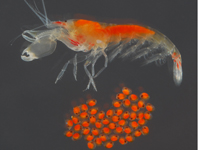Abstract
A new bdelloid rotifer, Coronistomus impossibilis gen. nov., sp. nov. is described from the Hawlings River in Maryland, USA. The new species is a non-swimming sediment dweller that exceeds 550 µm in body length. Its corona is a weakly bilobed ciliated field on the ventral side of the head with lateral borders continuing into mouth. The species has ramate trophi that have on each half three widely spaced major teeth with two interproximal teeth. The foot lacks spurs and ends with a pair of long, thick ventral toes and a medially positioned caudal appendage. The new species lives in microhabitats exposed to turbulent flow and its morphological idiosyncrasies are interpreted as adaptations to reduce the likelihood of getting dislodged by the water. Although the corona morphology and the caudal appendage of the new species are similar to the corresponding traits of some of the species in the family Philodinavidae, the structure of its nonprotrusible trophi and its possession of only two toes (as opposed to four) separate it from all other members of the Philodinavidae. Therefore, a new family, Coronistomidae fam. nov., is erected for the new genus Coronistomus.
References
Bartoš, E. (1951) The Chechoslovak rotatoria of the order Bdelloidea. Věstník Československé zoologické společnosti, 15, 241–500.
Beauchamp, P.M. de (1909) Recherches sur les rotifères: les formations tégumentaires et l’appareil digestif. Archives de Zoologie Expérimentale et Generale, Série 4, 10, 1–410.
Brakenhoff, H. (1937) Zur Morphologie der Bdelloidea. Zoologische Jahrbücher, 63, 125–182.
Cubitt, C. (1872) Remarks on the homological position of the members constituting the thecated section of the class Rotatoria. Monthly Microscopical Journal, 8, 5–12.
https://doi.org/10.1111/j.1365-2818.1872.tb02160.x
Hartog, M. (1896) Rotifers. In: Harmer, S.F. & Shipley, A.E. (Eds.), The Cambridge Natural History, volume II. Macmillan & Co., New York, pp. 1–560.
https://doi.org/10.5962/bhl.title.1091
Hochberg, R. & Litvaitis, M.K. (2000) Functional morphology of the muscles in Philodina sp. (Rotifera: Bdelloidea). Hydrobiologia, 432, 57–64.
https://doi.org/10.1023/A:1004003509017
Hudson, C.T. & Gosse, P.H. (1889) The Rotifera or Wheel-animalcules. Vol. 1. Longmans, Green, and Co., London, 128 pp.
https://doi.org/10.5962/bhl.title.39555
Kaya, M., Herniou, E.A., Barraclough, T.G. & Fontaneto, D. (2009) A faunistic survey of bdelloid rotifers in Turkey. Zoology in the Middle East, 48, 114–116.
https://doi.org/10.1080/09397140.2009.10638379
Lampert, W. & Sommer, U. (2007) Limnoecology. Oxford University Press, Oxford, 324 pp.
Leasi, F. & Ricci, C. (2010) Musculature of two bdelloid rotifers, Adineta ricciae and Macrotrachela quadricornifera: organization in a functional and evolutionary perspective. Journal of Zoological Systematics and Evolutionary Research, 48, 33–39.
https://doi.org/10.1111/j.1439-0469.2009.00538.x
Lengerer, B. & Ladurner, P. (2018) Properties of temporary adhesion systems of marine and freshwater organisms. Journal of Experimental Biology, 221, jeb182717.
https//doi.org/10.1242/jeb.182717
Lukashanets, D.A. (2018) Fauna and taxonomy of the subclass Bdelloidea Hudson (Class Eurotatoria De Ridder; phylum Rotifera Cuvier) in Belarus, the Eastern Europe Region. Zoology and Ecology, 28, 36–45.
https://doi.org/10.1080/21658005.2017.1417101
Melone, G. & Ricci, C. (1995) Rotatory apparatus in bdelloids. Hydrobiologia, 313/314, 91–98.
https://doi.org/10.1007/BF00025935
Milne, W. (1916) On the bdelloid rotifera of South Africa. Part 1. Journal of the Quekett Microscopical Club, 13, 47–84.
https://doi.org/10.5962/bhl.part.9295
Nielsen, A. (1950) The torrential invertebrate fauna. Oikos, 2, 176–196.
https://doi.org/10.2307/3564791
Örstan, A. (1998). Factors affecting long-term survival of dry bdelloid rotifers: a preliminary study. Hydrobiologia, 387/388, 327–331.
https://doi.org/10.1023/A:1017060325509
Örstan, A. (2015) A method for the preservation of bdelloid rotifers for taxonomical and anatomical studies. Quekett Journal of Microscopy, 42, 355–359.
Örstan, A. (2018) Taxonomic morphology of the genus Adineta (Rotifera: Bdelloidea: Adinetidae) with a new species from a suburban garden. Zootaxa, 4524 (2), 187–199.
https://doi.org/10.11646/zootaxa.4524.2.3
Örstan, A. (2020) Taxonomical characterization of bdelloid rotifers in the family Philodinidae. Quekett Journal of Microscopy, 43, 611–620.
Ricci, C. & Melone, G. (1998) The Philodinavidae (Rotifera Bdelloidea): a special family Hydrobiologia, 385, 77–85.
https://doi.org/10.1023/A:1003458611180
Silvester, N.R. & Sleigh, M.A. (1985) The forces on microorganisms at surfaces in flowing water. Freshwater Biology, 15, 433–448.
https://doi.org/10.1111/j.1365-2427.1985.tb00213.x
Song, M.O. & Lee, C.-H. (2019) Four new bdelloid rotifers from Korea. Zootaxa, 4571 (2), 201–224.
https://doi.org/10.11646/zootaxa.4571.2.2
Statzner, B. (2008) How views about flow adaptations of benthic stream invertebrates changed over the last century. International Review of Hydrobiology, 93, 593–605.
https://doi.org/10.1002/iroh.200711018
Turner, P.N. & Palmer, M.A. (1996) Notes on the species composition of the rotifer community inhabiting the interstitial sands of Goose Creek, Virginia with comments on habitat preferences. Quekett Journal of Microscopy, 37, 552–565.


